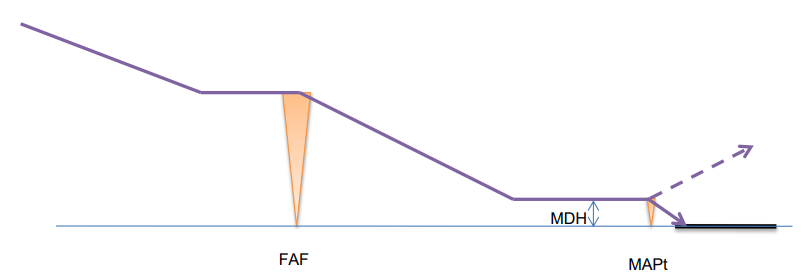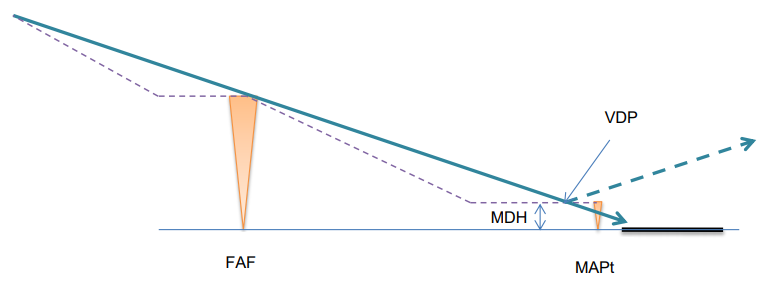¶ Introduction
A constant descent approach (CDA) is designed to reduce fuel consumption and noise compared to other conventional descents. It is also known as Optimized Profile Descent (OPD).
Instead of approaching an airport in a stair step fashion, throttling down and requesting permission to descend to each new lower altitude, CDA allows for a smooth, constant-angle descent to ensure the best chance of a stabilised approach and a smooth approach profile until the runway is in sight.
A continuous descent final approach (CDFA) is a technique, consistent with stabilized approach procedures, for flying the final approach segment of a non-precision instrument approach procedure as a continuous descent, without level-off, from an altitude/height at or above the final approach fix altitude/height to a point approximately 15 m (50 ft) above the landing runway threshold or the point where the flare manoeuvre should begin for the type of aircraft flown.
- CDFAs with advisory VNAV guidance calculated by on-board are considered 3D instrument approach operations.
- CDFAs with manual calculation of the required rate of descent are considered 2D instrument approach operations.
¶ Description
¶ Basic non-precision approach
During a non-precision approach procedure, the pilot with his aircraft descends to join the final approach fix (FAF) at the required height. Then he starts the descent until reaching the minimum descent height (MDH) and maintains this height until either the runway is in sight or the missed approach point (MAPt) is reached.

The descent to the MDH may be at any convenient rate of descent. Some procedures can include check heights or step down fixes at various points during the approach.
The disadvantages of this procedure are that the approach path includes several changes in the descent phase, making it difficult to achieve a stabilised approach and smooth transition to visual flight.
¶ Constant descent angle approach (CDA)
A continuous descent approach starts from the top of descent (or intermediate top of descent point due to airports constraints) and allows the aircraft flying its individual optimal vertical profile down to the runway threshold.
The pilot with his aircraft descends now at a constant rate from the top of descent point or latest at the FAF, which, if continued below the MDH, the aircraft at the runway threshold should be in a position to land the aircraft.
The (constant angle) approach path crosses the MDH at the Visual Descent Point (VDP). If the runway is not in sight when the aircraft reaches the VDP, a go-around is flown.

The path of the CDA approach is coloured blue and the standard non-precision approach path is light dashed purple.
The main advantage of the constant descent angle approach is that the descent angle is constant in order to ensure the best chance of a stabilised approach and smooth transition to visual flight. There are also advantages of fuel consumption and noise reduction which can be lower than the normal procedure.
- None
- None
- VID 150259 - Creation
- VID 200696 - Wiki Integration
- VID 496402 - Wiki.js integration